 Proving Whiskey
Proving Whiskey Proving Whiskey
Proving WhiskeyWhat does proof mean when it refers to whiskey (and other distilled alcoholic beverages), and where did the term come from? Well, first here is the modern definition: proof is twice the percentage of alcohol by volume. Therefore, 100 proof is 50% alcohol. 200 proof is 100% alcohol.
By volume means that the amount of both the alcohol and the water are measured in volume units.
| 40 % by volume (80 proof) |
40 mL alcohol + 60 mL water | 40% = | 40 mL alcohol | = |
40 mL alcohol |
| (40 mL alcohol+60 mL water) | 100 mL total |
| 50 % by volume (100 proof) |
50 mL alcohol + 50 mL water | 50% = | 50 mL alcohol | = |
50 mL alcohol |
| (50 mL alcohol+50 mL water) | 100 mL total |
Story goes that in the very old days, whiskey was "proved" to be good whiskey (that is it had enough alcohol in it, and had not been watered down), by pouring some whiskey on some gunpowder. Touch a match to the powder, and if it ignited it was "proof" that it was good whiskey. However, if there was too much water in the whiskey, the powder would be too wet to ignite. Then you have proof that its not good whiskey.
About 50% alcohol-water mixtures will allow gunpowder to catch on fire. Thus the 50% alcohol became 100% proof that it was good whiskey, which is why today it is called 100 proof whiskey.
Reference: http://www.dcs.ed.ac.uk/home/jhb/whisky/swa/chap6.html